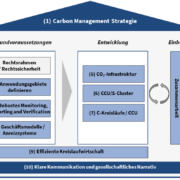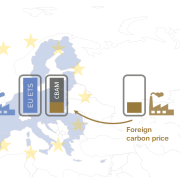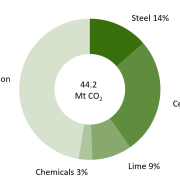Carbon Management and CCU/S in Germany
The German government is currently developing a Carbon Management Strategy for CO2 storage and utilisation. Because, one thing is indisputable: Without the capture, use and storage of CO2 from industrial processes (CCU/S) and the atmosphere, Germany can hardly become climate neutral by 2045. The basis for the Carbon Management Strategy is the new evaluation report on the Carbon Dioxide Storage Act. In this article, we explain the key points and principles of such a strategy.
The CCU/S nomenclature
For the purposes of consistent nomenclature, we use the term carbon management below as an umbrella term for carbon management that includes CO2 capture, transport, and use (CCU) or storage (CCS) from fossil as well as biological or atmospheric sources as negative emissions or carbon dioxide removal (BECCS and DACCS). Likewise, dealing with other nature-based solutions to remove and reduce greenhouse gas emissions from the atmosphere is part of carbon management (see Figure 1).
The impact on the climate and the technical and economic details of the different technologies and options are complex and require detailed analysis. Feel free to contact us for more information.
Carbon management necessary for climate neutrality
In early January 2023, German Economics Minister Robert Habeck travelled to Norway to explore further cooperation in the field of energy and climate. Among other things, the topic of CO2 capture, transport and storage is to become an important part of the cooperation with Norway. With tightening climate targets at EU and German level, it is becoming increasingly clear that greenhouse gas or climate neutrality by mid-century will not be achieved without large-scale capture, utilisation and, above all, long-term storage of CO2.
At the same time, the German Federal Ministry of Economics and Climate Protection (BMWK) published the German government’s evaluation report on the Carbon Dioxide Storage Act (KSpG) in December 2022. The KSpG came into force in August 2012 and was intended to test the first demonstration projects for the long-term storage of CO2 in the ground in Germany. Acceptance of CO2 storage in Germany has always been very low in the past, especially as the discourse was strongly linked to the use of CO2 capture at coal-fired power plants and the continued operation of coal power plants. However, by the end of the application deadline for approval of new underground CO2 storage facilities (end of 2016), only one demonstration project had been applied for and been built in Germany. Since no new applications can be submitted after the end of 2016, underground CO2 storage is de facto not possible throughout Germany.
CO2 capture for residual emissions in industry
In the future, the use of CCS at coal-fired power plants in Germany is not expected to play a role due to the planned phase-out of coal. Capture, utilisation or storage of CO2 will however be needed primarily for a climate-neutral industry. Even after the use of renewable energies or electrification, large quantities of process-related CO2 emissions will still be produced, for example in the lime and cement industries or in the steel industry. Carbon is also the starting point for many other important products in the chemical industry and is therefore also needed as a raw material. The long-term scenarios project assumes that around 30 million metric tons of CO2 will have to be captured, transported, reused or disposed of in final storage by industrial plants in Germany even after climate neutrality has been achieved in 2045. Possible locations of capture plants and transport pipelines for CO2 are shown in Figure 2.
Here, it is noticeable that clusters of CCU/S sites are located in the core areas of German basic and heavy industry. This clustering is mainly due to economic economies of scale for infrastructures for capture, transport but also the potential reuse of CO2. Accordingly, the focus of the German Carbon Management Strategy will be primarily on the industrial sector and not on capture in coal-fired power generation.
In addition to the capture of CO2 at industrial sources, however, the use of carbon removal solutions, i.e., the physical removal of CO2 emissions from the atmosphere, must also be developed. Carbon removal is the only way to offset the greenhouse gas emissions that will continue to occur in 2045, for example from agriculture. At 45-80 million metric tons of CO2, the negative emissions required are actually at a higher level than CO2 emissions to be captured from industrial processes. We have presented the details here and here.
Key principles of the German carbon management strategy
The use of CCU/S in industry will play a role as a decarbonisation option, alongside energy and resource efficiency and the use of green energy sources and electrification of processes. Key findings from the latest climate neutrality studies for Germany (Klimaneutrales Deutschland 2045, Klimapfade 2.0, dena-Leitstudie Aufbruch Klimaneutralität, Langfristszenarien) allow the following assessments:
- Increase in ambition level of climate targets leads to increased use of CCU/S
- CO2 capture in the million metric ton range necessary as early as 2030
- Use of CCS mainly in industry and waste sector
- Negative emissions from carbon dioxide removal must be scaled up from 2030 at the latest
- Permanence of CO2 removal and storage by nature-based methods is uncertain and therefore makes technical solutions necessary as well
- Fossil CCU/S and technical carbon dioxide removal can use the same infrastructures and should be considered in an integrated way
- Transparent and continuous dialogue needed to ensure societal acceptance for ramp-up of CCU/S
- Significant amounts of CO2 capture at global level (6-12 Gt/year depending on scenario) also driven by CCS at fossil power plants
The recently published evaluation report on the KSpG provides the following key recommendations to the German government for revision: Examination and adjustment of regulations of the (cross-border) transport of CO2 and regarding German final storage sites for CO2, the further integration of CCU/S into the European Emissions Trading System (EU ETS), and the development of a clear framework for accounting of negative emissions. The details are to be elaborated in a German Carbon Management Strategy (Figure 3) by the German government, which will be presented during 2023.
Which issues need to be clarified?
The German Carbon Management Strategy first aims to spell out a prioritisation of CCU/S applications. Questions must be answered for which industries and which emissions CCU/S measures are most important in order to use available resources in an appropriate manner. This should go hand in hand with the adaptation of the relevant regulatory framework, for example for approval procedures and the development and financing of (transport) infrastructures. Measures and funding programs in special application areas are also to be developed.
Methodologies for monitoring, reporting and verification (MRV) for CCU/S need to be developed. For example, the accounting of CCU/S in the EU ETS and the accounting for the use of CO2 from different sources (fossil, industrial cycle, biogenic, from the atmosphere) in the chemical industry and in the production of synthetic fuels must be clarified.
In particular, the possibility of transboundary CO2 transport will play a major role across the EU. In this regard, the Norwegian government has already made offers to the EU industry for accommodating their CO2 in underground storages in Norway. The design of pipeline and ship capacities as well as questions of EU network regulation and financing are important issues. The synergy effects of CCU/S clusters between industries as sources and sinks of CO2 must be elicited to find the most efficient solutions when planning infrastructures.
For possible CO2 storage facilities to become a reality also on German territory (probably rather under the seabed than under the mainland), social acceptance for CO2 capture and final storage must be built up. This can only happen through clear and transparent communication regarding the necessity of CCU/S for a climate neutral Europe and Germany.
We will keep you up to date on the latest developments regarding the German Carbon Management Strategy. Please feel free to contact us if you have any questions on this topic.






 carboneer
carboneer
Leave a Reply
Want to join the discussion?Feel free to contribute!